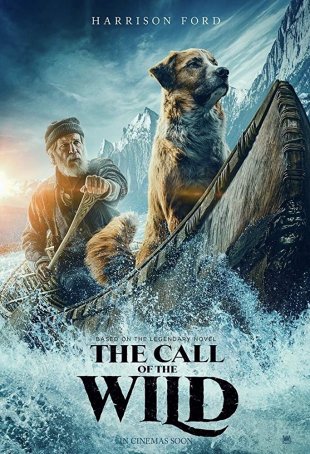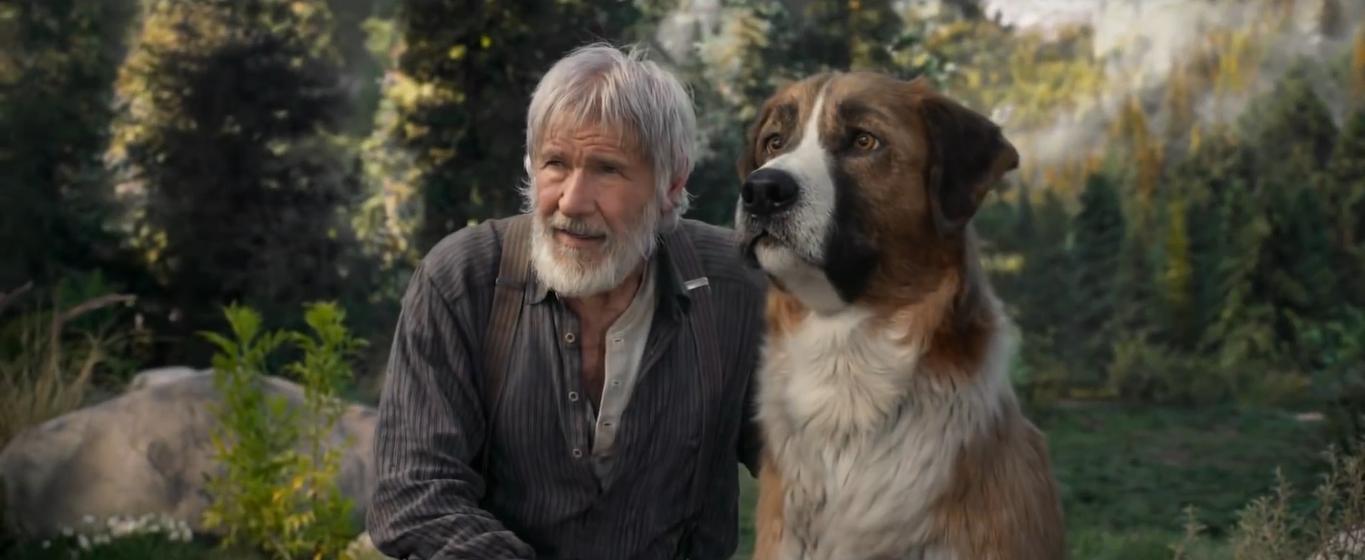Call of the Wild, The (United States, 2020)
February 21, 2020
Note: some spoilers discussing differences between the book and movie.
I’ll admit to being disappointed by the newest adaptation of Jack London’s The Call of the Wild. The motion capture technology that creates a dog out of the efforts of a former Cirque du Soleil performer (thereby giving the director complete control over the animal’s movements, interaction, and facial expressions) is impressive and about 98% believable (there are occasional “glitches”). Harrison Ford gives as dignified a performance as he has managed in many years. And the cinematography (by veteran Janusz Kaminski) is glorious. But the tonal shifts threaten to cause whiplash and the “improvements” made to London’s book (presumably to make it more cinematic) undermine both the thematic and narrative integrity of the tale. Do we really need some of the visual clutter supplied by director Chris Sanders and screenwriter Michael Green? How does this improve a story that has been beloved since its publication nearly 120 years ago?
The film’s protagonist is Buck, whose motion capture was provided by Terry Notary, and the episodic story follows his progression from a pampered house pet to the alpha male of a dog/wolf tribe beyond the reach of humans. At the beginning of The Call of the Wild, the 140-pound St. Bernard-Scotch Collie mixed canine is the loyal but disruptive pet of Judge Miller (Bradley Whitford), who lives in California’s Santa Clarita Valley. After being abducted and taught the “law of the club,” Buck ends up as a member of a dog sled team owned by French-Canadian mail dispatchers, Perrault (Omar Sy) and Francoise (Cara Gee), who treat him well. When their commission is cancelled, they are forced to sell the animals. Buck’s next masters are a trio of arrogant, pampered Americans who have come to the Yukon in search of gold. Hal (Dan Stevens), his sister Mercedes (Karen Gillan), and her husband Charles (Colin Woodell), abuse the dogs. An exhausted Buck is rescued by outdoorsman John Thornton (Harrison Ford) but the others perish with Charles and Mercedes when they attempt to cross a river during the spring thaw. Hal survives and dedicates himself to tracking down and killing Buck and Thornton.
The CGI is undeniably impressive. In most instances, Buck is so lifelike that it’s difficult to believe he was never portrayed by a real animal. Sanders (who previously directed Lilo & Stitch and How to Train Your Dragon) is no stranger manipulating animated characters but this is the first time he has had to contend with real-life ones. His work in the live-action realm is middling. Harrison Ford, who has spent a career acting opposite creatures who aren’t there, is comfortable in the role (he also doubles as narrator) and brings a relatable world-weariness to the part of a man who lives a nomadic existence following the death of his son and the disintegration of his marriage. Dan Stevens, on the other hand, is painfully over-the-top as a cartoonish villain created for the movie. (The character of Hal is only briefly in the book, dying with Charles and Mercedes.) There are other notable actors in the movie – Karen Gillan, Omar Sy, Cara Gee, Bradley Whitford – but none have much screen time.
 Sanders has trouble with tone and pacing. At times, he
treats the material almost as slapstick, such as in early scenes where Buck
creates mayhem in and around the Judge’s household. At other times, it’s dark
(as when a trainer clobbers Buck with a club) and frightening (the fight
between Buck and his dog-rival Spitz). Many of the scenes with Thornton are
melancholy, especially when he composes a letter to his estranged wife
explaining why he left her. The parts of the movie that seem geared toward
younger viewers may try the patience of an adult while the more mature elements
may bore children. In trying to reach as broad an audience as possible, Sanders’
narrative is a mismatched quilt. The film also adds action scenes that weren’t
in the novel. The most outlandish of these are an underwater rescue and an avalanche
escape. Toward the end, the movie diverges significantly from the book and few
(if any) of the changes are for the better.
Sanders has trouble with tone and pacing. At times, he
treats the material almost as slapstick, such as in early scenes where Buck
creates mayhem in and around the Judge’s household. At other times, it’s dark
(as when a trainer clobbers Buck with a club) and frightening (the fight
between Buck and his dog-rival Spitz). Many of the scenes with Thornton are
melancholy, especially when he composes a letter to his estranged wife
explaining why he left her. The parts of the movie that seem geared toward
younger viewers may try the patience of an adult while the more mature elements
may bore children. In trying to reach as broad an audience as possible, Sanders’
narrative is a mismatched quilt. The film also adds action scenes that weren’t
in the novel. The most outlandish of these are an underwater rescue and an avalanche
escape. Toward the end, the movie diverges significantly from the book and few
(if any) of the changes are for the better.
Even considering how the advances of technology give the filmmakers complete control over the use of animals, making a movie about an anthropomorphized dog who doesn’t talk is a tall order. Even though it seems an unlikely candidate for the big screen, London’s book has been adapted a number of times – first as a silent film in 1923, then in 1935 with Clark Gable and 1972 with Charlton Heston, and most recently in 1997 with Rutger Hauer. None of these films were entirely successful (the 1997 one is the best of the talkies) and Sanders’ new interpretation enters the roster as another swing-and-a-miss. It’s not an awful project – Ford and the cinematography are highlights but when a viewer is spending too much time meditating about the remarkable technology that has brought Buck to life, something is amiss. A stronger focus on story and tone and less reliance on the marvels of CGI might have made this latest version of The Call of the Wild a more fruitful experience.
Call of the Wild, The (United States, 2020)
Cast: Harrison Ford, Dan Stevens, Bradley Whitford, Karen Gillen, Cara Gee, Omar Sy, Colin Woodell, Terry Notary
Home Release Date: 2020-05-12
Screenplay: Michael Green, based on the book by Jack London
Cinematography: Janusz Kaminski
Music: John Powell
U.S. Distributor: 20th Century Studios
- Raiders of the Lost Ark (1981)
- Star Wars Episode V: The Empire Strikes Back (1980)
- Star Wars: The Empire Strikes Back (1980)
- Darkest Minds, The (2018)
- Godzilla: King of the Monsters (2019)
- (There are no more worst movies of Bradley Whitford)

Comments